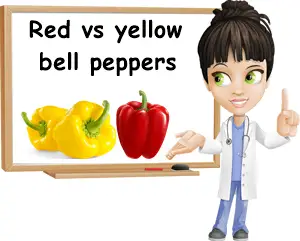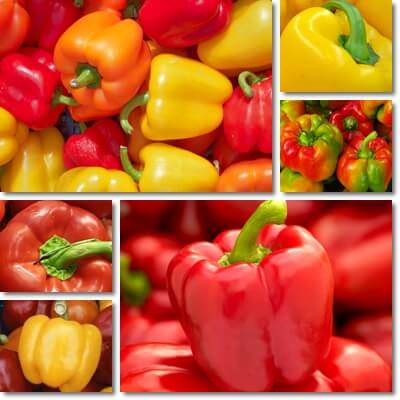Red and yellow bell peppers are actually quite closely related and share a great deal of nutritional properties and health benefits. The two are different color variants of the same fruit, the bell pepper, also known as the sweet pepper or the Holland pepper (scientific name: Capsicum annuum). But there are a few differences between them aside for color. For example, there’s more vitamin A in red bell peppers versus yellow, but more vitamin C in yellow. There are also differences in antioxidant profile, that is carotenes vs xanthophylls, and content of vitamins B1, B2, B5, B6 and B9 as well as differences in taste.
Are red and yellow bell peppers the same?
Yes and no. They are the same in the sense that they are the same botanical fruit, scientifically known as Capsicum annuum. They are different in the sense that they are two visibly different color variants of the same fruit: one red and one yellow. A lot of people mistakenly believe that all bell peppers start out green, then change color a few times, going from green to yellow then orange and finally red. It’s true there are bell peppers that change color more than once as they ripen – for example, some fruits go from green to purple to black, from green to black then to red or from green to yellow and then develop red stripes. But under normal circumstances, commercial varieties of red and yellow bell pepper change color only once, that is, from green to either red or yellow.

Are red and yellow bell peppers green first?
Yes, both red and yellow bell peppers are green first. Both of them are initially green (when unripe), but begin to change color as they start to ripen. The only difference is one turns red, while the other turns yellow. Contrary to myths perpetuated online, they do not change colors successively, in the order of the color spectrum (yellow – orange – red). Although there is one variety called the yellow and red striped bell pepper or the Holland striped bell pepper which turns yellow with red stripes at maturity (trademark names are Aloha and Enjoya). While it is said the stripped pattern occurred naturally as a mutation (plants can develop new traits all of a sudden), apparently, you can’t grow the striped red and yellow bell pepper from seeds.
Red vs yellow bell peppers nutrition
- Macro-nutrients content (values for 100 g):
- Energetic value/Calorie content: 26-27 kcal (kilo-calories)
- Protein: 0.99 g vs 1 g
- Fat: 0.3 g vs 0.1 g
- Carbohydrates: 6 g vs 6.3 g
- Sugars: 4.2 g vs undetermined amount
- Dietary fiber: 2.1 vs 0.9 g
- Micro-nutrients content (values for 100 g):
- Vitamin A: 157 mcg vs 10 mcg (mcg means ‘micrograms’)
- Vitamin B1: 0.054 mg vs 0.028 mg
- Vitamin B2: 0.085 mg vs 0.025 mg
- Vitamin B3: 0.979 mg vs 0.890 mg
- Vitamin B5: 0.317 mg vs 0.168 mg
- Vitamin B6: 0.291 mg vs 0.168 mg
- Vitamin B9: 46 mcg vs 26 mcg
- Vitamin B12: 0 mcg
- Vitamin C: 127.7 mg vs 183.5 mg
- Vitamin D: 0 mcg
- Vitamin E: 1.58 mg vs (not available, but presumed low)
- Vitamin K: 4.9 mcg vs (not available, but presumed low)
- Calcium: 7 mg vs 11 mg
- Copper: 0.017 mg vs 0.107 mg
- Iron: 0.43 mg vs 0.46 mg
- Magnesium: 12 mg vs 12 mg
- Manganese: 0.112 mg vs 0.117 mg
- Phosphorus: 26 mg vs 24 mg
- Potassium: 211 mg vs 212 mg
- Selenium: 0.1 mcg vs 0.3 mcg
- Sodium: 4 mg vs 2 mg
- Zinc: 0.25 mg vs 0.17 mg

What are the differences?
- The difference in bell peppers taste between the two colors is minimal, but distinguishable. Red bell peppers are the sweetest of all colors, versus yellow bell peppers which are also sweet, but not as much. If unripe, both colors taste bitter. Green parts on the fruits will also taste bitter.
- Red bell peppers owe their color to both carotene pigments such as beta-carotene and alpha-carotene, and xanthophyll pigments such as lutein and zeaxanthin, but have more carotenes. Carotenes are more commonly responsible for orange, pink and red colors in plants and even some animals like flamingos or salmon. Moreover, carotenes such as beta-carotene have pro-vitamin A activity which means they are converted into vitamin A in the body. Red bell peppers have 1624 mcg of beta-carotene per 100 g, vs yellow bell peppers which have only 120 mcg of beta-carotene.
- Red bell peppers have 157 mcg of vitamin A per 100 g vs yellow bell peppers which have only 10 mcg of vitamin A per 100 g. The reason they are higher in vitamin A is because they have a lot more beta-carotene and other carotenes with vitamin A activity.
- Yellow bell peppers owe their color to both carotene pigments such as beta and alpha-carotene, and xanthophyll pigments such as lutein, zeaxanthin, alpha and beta-cryptoxanthin, but have more xanthophylls. Xanthophylls are more commonly responsible for the yellow colors of plants, but also egg yolk and chicken and other poultry fat and skin. Unlike carotenes, xanthophylls do not have vitamin A activity which explains the lower vitamin A content of yellow bell peppers.
- Despite the difference in vitamin A content, both red and yellow bell peppers are equally good for eyesight because both carotenes with vitamin A activity and xanthophylls without vitamin A activity provide important benefits for the eyes. For example, both vitamin A from carotenes and lutein and zeaxanthin xanthophylls contribute to good visual acuity, color vision and overall eye health.
- Yellow bell peppers have 183.5 mg of vitamin C, versus red which have 127.7 mg of vitamin C (values for 100 g serving). Even though yellow ones have a higher vitamin C content, both colors actually provide more than the recommended daily intake of vitamin A for an average adult in just one 100 g serving (3.5 oz).
- Other nutritional differences: red bell peppers have about double the vitamin B1 (thiamine) content of yellow bell peppers, triple the vitamin B2 (riboflavin) content, almost double the vitamin B5 (pantothenic acid) and vitamin B9 (folate) content and more vitamin B6. But overall, both colors are good sources of several B vitamins, especially vitamins B3 and B6, but fairly low in vitamins E and K. There is no vitamin D and no vitamin B12 in either color.
- Mineral content is fairly similar, low in both colors, but also dependent on soil mineral availability. Potassium and manganese content are the highest in both colors, at an average of 5% of recommended daily requirements for an average adult (determined for a serving of 100 g).
Conclusion
Whichever of the two colors you may like to eat, know that there are benefits to both of them, despite the differences in nutrition. Both red and yellow bell peppers have anti-inflammatory, antioxidant, antibacterial, antiviral, wound-healing, anti-hypertensive and anti-anemia properties. They both make a good food to eat for healthy weight loss and have a low glycemic index (GI) and an even lower glycemic load (GL) which is good for diabetes and blood sugar control. Due to a high vitamin C content, eating red and yellow bell peppers stimulates collagen production and improves skin elasticity, providing anti-aging benefits for the skin. Vitamin C and vitamins B6 and B9 increase iron absorption from foods and help make red blood cells for a boost in energy levels and more vitality. Vitamin B3 has LDL cholesterol-lowering properties and HDL cholesterol-raising properties, while potassium is good for high blood pressure. For good eyesight and eye health, it’s a good idea to eat both colors.
